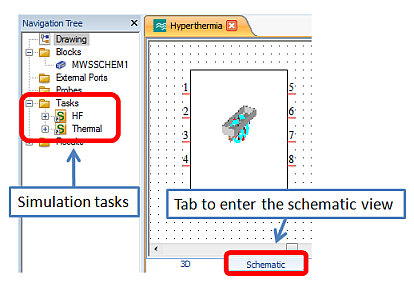

This example contains one of the CST Voxel Family and needs a special license to be loaded. It is part of the CST MPHYSICS STUDIO examples collection and may not be present if these had been deselected during the installation process.

Hyperthermia is a medical therapy using focused RF radiation to locally heat up tumor tissue inside a body in order to treat cancer. It makes use of the effect that tumor cells are slightly more sensitive to over-heating than healthy cells are and may be killed by the increased temperature. Hyperthermia is typically used alongside conventional therapies such as application of anti-cancer drugs.
For this example the patient is assumed to have an endorectal carcinoma to be treated. A set of eight dipole antennas are placed around her body. To avoid significant reflection of the waves at the air-skin boundary, a cylindrical water bag is placed between the body and the antennas.
Hyperthermia is a typical application where the complete technology approach of CST is needed. The transient solver of CST MICROWAVE STUDIO is used to simulate the field distribution of the antennas as well as the EM power loss density inside the body. The bioheat solver in CST MPHYSICS STUDIO is finally used to convert the losses into a real temperature distribution taking into account effects of living tissue such as metabolic heating and blood flow influence.
The project consists of a master project, which is visible after opening in CST STUDIO SUITE and two simulation tasks, which are basically derived sub projects. To access these simulation tasks one has to switch to the schematic view of the master project:

Both tasks were derived from the master project and contain further problem-specific settings which are described below:
For reasons of simplicity all eight dipoles were excited simultaneously with the same amplitudes and phases. For simulations of the real device all phases and amplitudes could be modified in order to optimize the focusing on the area of the tumor. A power-loss monitor was defined at the operating frequency of 90 MHz to be used as a source for the following thermal simulation. To export loss distributions automatically after the transient solver was finished, the postprocessing template "Export thermal losses" was used.
After finishing the high frequency simulation task,
the thermal task follows. In addition to the existing material settings,
a convection of 10 W/kg/m² is defined for the materials skin and fat.
In Simulation:
Sources and Loads Thermal
Losses
Thermal
Losses ![]() the
losses from the HF task. The thermal stationary solver predicts the final
steady state temperature. To investigate the heating process itself the
transient thermal solver can give valuable insight.
the
losses from the HF task. The thermal stationary solver predicts the final
steady state temperature. To investigate the heating process itself the
transient thermal solver can give valuable insight.